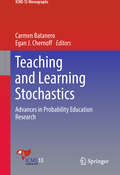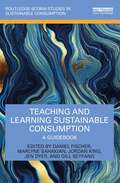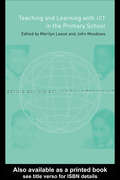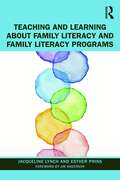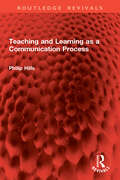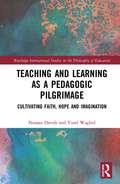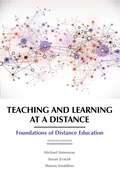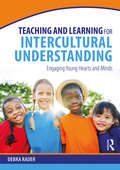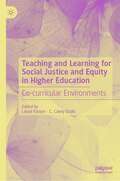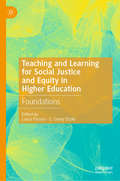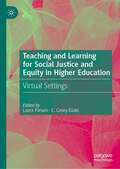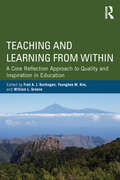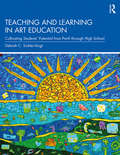- Table View
- List View
Teaching and Learning Source-Based Writing: Current Perspectives and Future Directions
by Rosemary WetteThis volume brings together significant findings, approaches, and research-based pedagogies on teaching and learning source-based writing. A comprehensive update to the field, this book presents source-based writing as an essential skill that comes with its own specific set of challenges, requiring a complex set of literacy skills and capabilities for mastery. With contributors from leading scholars from around the world, the volume addresses source-based writing as a developmental issue and offers guidance for supporting novice academic writers on their path toward proficiency and accumulation of multifaceted skill set. Chapters cover key topics, including metacognitive skills, the flipped classroom, scaffolding, assessment, and ethical considerations. With research reviews, practical considerations and future directions as components of each chapter, this book is ideal for courses on academic writing and second language writing.
Teaching and Learning Stochastics: Advances In Probability Education Research (ICME-13 Monographs)
by Carmen Batanero Egan J ChernoffThis book presents a collection of selected papers that represent the current variety of research on the teaching and learning of probability. The respective chapters address a diverse range of theoretical, empirical and practical aspects underpinning the teaching and learning of probability, curricular issues, probabilistic reasoning, misconceptions and biases, as well as their pedagogical implications. These chapters are divided into THREE main sections, dealing with: TEACHING PROBABILITY, STUDENTS' REASONING AND LEARNING AND EDUCATION OF TEACHERS.In brief, the papers presented here include research dealing with teachers and students at different levels and ages (from primary school to university) and address epistemological and curricular analysis, as well as the role of technology, simulations, language and visualisation in teaching and learning probability. As such, it offers essential information for teachers, researchers and curricular designers alike.
Teaching and Learning Strategies
by Diana WhittonTeaching and Learning Strategies is a practical guide for pre-service teachers who know and understand the content of the curriculum and are looking for additional tools to teach it effectively. This book will help students to develop a comprehensive knowledge of teaching and learning strategies, which is essential in ensuring lessons are effective and lead to successful outcomes. The text outlines a variety of teaching strategies that can be used to facilitate classroom learning and engagement. Strategies and methods covered include discovery learning, experiments, demonstrations, the use of questioning, the facilitation of discussion and the effective provision of feedback. Teachers will be able to integrate the strategies in this book with any content area and any age group or activity level. Teaching and Learning Strategies is a useful resource for teachers during the practicum component of their course and throughout their teaching career.
Teaching and Learning Sustainable Consumption: A Guidebook (Routledge-SCORAI Studies in Sustainable Consumption)
by Daniel Fischer Marlyne Sahakian Gill Seyfang Jordan King Jen DyerThis book is a comprehensive guide on how to teach sustainable consumption in higher education. Teaching and Learning Sustainable Consumption: A Guidebook systematizes the themes, objectives, and theories that characterize sustainable consumption as an educational field. The first part of the book discusses approaches to teaching and learning sustainable consumption in higher education, including reflections on how learning occurs, to more practical considerations like how to set objectives or assess learning outcomes. The second part of the book is a dive into inspiring examples of what this looks like in a range of contexts and towards different aims – involving 57 diverse contributions by teachers and practitioners. Building on the momentum of a steady increase in courses addressing sustainable consumption over the past decade, this guidebook supports innovative approaches to teaching and learning, while also bringing to the fore conceptual debates around higher education and sustainability. Overall, this book will be a seminal resource for educators teaching about sustainability and consumption. It will help them to navigate the specifics of sustainable consumption as a field of scholarship, and design their teaching approaches in a more informed, competent, and creative way.
Teaching and Learning Team Sports and Games
by Jean-Francis Gréhaigne Jean-François Richard Linda L. GriffinWritten as a resource for both pre-service and in-service educators, this theory-to-practice book focuses on the foundations and applications of constructivism applied to the teaching and learning of invasion sports and games.
Teaching and Learning Through Inquiry: A Guidebook for Institutions and Instructors
by Virginia S. LeeInquiry-guided learning (IGL) refers to an array of classroom practices that promote student learning through guided and, increasingly independent investigation of complex questions and problems. Rather than teaching the results of others’ investigations, which students learn passively, instructors assist students in mastering and learning through the process of active investigation itself. IGL develops critical thinking, independent inquiry, students’ responsibility for their own learning and intellectual growth and maturity.The 1999 Boyer Commission Report emphasized the importance of establishing "a firm grounding in inquiry-based learning and communication of information and ideas". While this approach capitalizes on one of the key strengths of research universities, the expertise of its faculty in research, it is one that can be fruitfully adopted throughout higher education.North Carolina State University is at the forefront of the development and implementation of IGL both at the course level and as part of a successful faculty-led process of reform of undergraduate education in a complex research institution.This book documents and explores NCSU’s IGL initiative from a variety of perspectives: how faculty arrived at their current understanding of inquiry-guided learning and how they have interpreted it at various levels -- the individual course, the major, the college, the university-wide program, and the undergraduate curriculum as a whole. The contributors show how IGL has been dovetailed with other complementary efforts and programs, and how they have assessed its impact. The book is divided into four parts, the first briefly summarizing the history of the initiative. Part Two, the largest section, describes how various instructors, departments, and colleges in a range of disciplines have interpreted inquiry-guided learning. It provides examples from disciplines as varied as ecology, engineering, foreign language learning, history, music, microbiology, physics and psychology. It also outlines the potential for even broader dissemination of inquiry-guided learning in the undergraduate curriculum as a whole. Part Three describes two inquiry-guided learning programs for first year students and the interesting ways in which NCSU’s university-wide writing and speaking program and growing service learning program support inquiry-guided learning. Part Four documents how the institution has supported instructors (and how they have supported themselves) as well as the methods used to assess the impact of inquiry-guided learning on students, faculty, and the institution as a whole.The book has been written with three audiences in mind: instructors who want to use inquiry-guided learning in their classrooms, faculty developers considering supporting comparable efforts on their campuses, and administrators interested in managing similar undergraduate reform efforts. It will also appeal to instructors of courses in the administration of higher education who are looking for relevant case studies of reform. While this is a model successfully implemented at a research university, it is one that is relevant for all institutions of higher education.
Teaching and Learning Through the Holocaust: Thinking About the Unthinkable
by Jeffrey Parker Anthony PellegrinoThis book serves as a critical resource for educators across various roles and contexts who are interested in Holocaust education that is both historically sound and practically relevant. As a collection, it pulls together a diverse group of scholars to share their research and experiences. The volume endeavors to address topics including the nature and purpose of Holocaust education, how our understanding of the Holocaust has changed, and resources we can use with learners. These themes are consistent across the chapters, making for a comprehensive exploration of learning through the Holocaust today and in the future.
Teaching and Learning Using ICT in the Primary School
by Marilyn Leask John MeadowsTeaching and Learning with ICT in the Primary School introduces teachers to the range of ways in which ICT can be used to support and extend the teaching and learning opportunities in their classrooms. Chapters cover areas such as: literacy, numeracy, science, and their relationship with ICT; managing curriculum projects using ICT; creating and using multimedia applications. Ideas and activities for teachers to try are based on tried and tested methods from innovative schools around the UK and abroad. Practising teachers and students will find this an invaluable guide on how to work together to extend their skills and knowledge in the area of ICT.
Teaching and Learning Vocabulary: Bringing Research to Practice
by Elfrieda H. Hiebert Michael L. KamilAlthough proficiency in vocabulary has long been recognized as basic to reading proficiency, there has been a paucity of research on vocabulary teaching and learning over the last two decades. Recognizing this, the U.S. Department of Education recently sponsored a Focus on Vocabulary conference that attracted the best-known and most active researchers in the vocabulary field. This book is the outgrowth of that conference. It presents scientific evidence from leading research programs that address persistent issues regarding the role of vocabulary in text comprehension. Part I examines how vocabulary is learned; Part II presents instructional interventions that enhance vocabulary; and Part III looks at which words to choose for vocabulary instruction.Other key features of this timely new book include:*Broad Coverage. The book addresses the full range of students populating current classrooms--young children, English Language Learners, and young adolescents.*Issues Focus. By focusing on persistent issues from the perspective of critical school populations, this volume provides a rich, scientific foundation for effective vocabulary instruction and policy.*Author Expertise. Few volumes can boast of a more luminous cast of contributing authors (see table of contents).This book is suitable for anyone (graduate students, in-service reading specialists and curriculum directors, college faculty, and researchers) who deals with vocabulary learning and instruction as a vital component of reading proficiency.
Teaching and Learning about Climate Change: A Framework for Educators
by Daniel P. Shepardson, Anita Roychoudhury and Andrew S. HirschResponding to the issues and challenges of teaching and learning about climate change from a science education-based perspective, this book is designed to serve as an aid for educators as they strive to incorporate the topic into their classes. The unique discussion of these issues is drawn from the perspectives of leading and international scholars in the field. The book is structured around three themes: theoretical, philosophical, and conceptual frameworks for climate change education and research; research on teaching and learning about global warming and climate change; and approaches to professional development and classroom practice.
Teaching and Learning about Family Literacy and Family Literacy Programs
by Jacqueline Lynch Esther PrinsThis book provides a systematic exploration of family literacy, including its historic origins, theoretical expansion, practical applications within the field, and focused topics within family literacy. Grounded in sociocultural approaches to learning and literacy, the book covers research on how families use literacy in their daily lives as well as different models of family literacy programs and interventions that provide opportunities for parent-child literacy interactions and that support the needs of children and parents as adult learners. Chapters discuss key topics, including the roles of race, ethnicity, culture, and social class in family literacy; digital family literacies; family-school relationships and parental engagement in schools; fathers’ involvement in family literacy; accountability and employment; and more. Throughout the book, Lynch and Prins share evidence-based literacy practices and highlight examples of successful family literacy programs. Acknowledging lingering concerns, challenges, and critiques of family literacy, the book also offers recommendations for research, policy, and practice. Accessible and thorough, this book comprehensively addresses family literacies and is relevant for researchers, scholars, graduate students, and instructors and practitioners in language and literacy programs.
Teaching and Learning about Technological Systems: Philosophical, Curriculum and Classroom Perspectives (Contemporary Issues in Technology Education)
by P. John Williams Jonas HallströmThis book discusses the teaching and learning about technological systems in technology education and adjacent curriculum areas. It describes, analyzes and synthesizes contemporary research on technological systems in technology education. By delving into the philosophy, sociology and history of technology, technology education and the learning and teaching of technological systems, it summarizes prior research and analyzes new research. This book thereby serves as a resource and reference work for professionals in this area of research and education.
Teaching and Learning as a Communication Process (Routledge Revivals)
by Philip HillsFirst published in 1979, Teaching and Learning as a Communication Process provides practical guidelines for closer communication between the teacher and the student. It is intended for all those engaged in teaching and learning in higher, further, and continuing education.The book examines the growth of formal education system; discusses verbal and non-verbal, audio-visual, interpersonal, and group communication, and reviews varieties of mass communication both historically and from future perspective. It considers student as receiver and teacher as sender of communication and explores three parts of the communication process in terms of specific guidelines for the preparation of effective teaching/learning materials.
Teaching and Learning as a Pedagogic Pilgrimage: Cultivating Faith, Hope and Imagination (Routledge International Studies in the Philosophy of Education)
by Nuraan Davids Yusef WaghidTeaching and Learning as a Pedagogic Pilgrimage is premised on an argument that if higher education is to remain responsive to a public good, then teaching and learning must be in a perpetual state of reflection and change. It argues in defence of teaching and learning as constitutive of a pedagogic pilgrimage and draws on a range of scholars and theories to explore concepts such as transcendental journeys, belief, hope and imagination. The main objective of the book is to show how teaching and learning ought to be reconsidered in relation to that which lies beyond the parameters of the encounters, as well as that which is intrinsic to the encounters. This book gives shape to rituals and routines of engagement and debate, before extending the limitations in deliberative pedagogic encounters to offer desirable outcomes in which both student and teacher can practice a spiritual take on teaching and learning along a continuum of ongoing action. Themes explored in the chapters include the following: Faith and deliberative encounters Post-human ethics of care in teaching and learning Diffracted teaching and learning This book will be of great interest to academics, researchers and post-graduate students in the fields of philosophy of education, and teaching and learning in the philosophy of education. It will also appeal to school and university educators, policymakers and prospective teachers.
Teaching and Learning at a Distance: Foundations of Distance Education
by Susan Zvacek Sharon E. Smaldino Michael R. SimonsonTeaching and Learning at a Distance is written for introductory distance education courses for preservice or in- service teachers, and for training programs that discuss teaching distant learners or managing distance education systems. This text provides readers with the basic information needed to be knowledgeable distance educators and leaders of distance education programs. The teacher or trainer who uses this book will be able to distinguish between appropriate uses of distance education. <p><p>In this text we take the following themes: The first theme is the definition of distance education. Before we started writing the first edition of Teaching and Learning at a Distance we carefully reviewed the literature to determine the definition that would be at the foundation of our writing. This definition is based on the work of Desmond Keegan, but is unique to this book. This definition of distance education has been adopted by the Association for Educational Communications and Technology and by the Encyclopedia Britannica. <p><p>The second theme of the book was the importance of research to the development of the contents of the book. The best practices presented in Teaching and Learning at a Distance are validated by scientific evidence. Certainly there are “rules of thumb”, but we have always attempted to only include recommendations that can be supported by research. <p><p>The third theme of Teaching and Learning at a Distance is derived from Richard Clark’s famous quote published in the Review of Educational Research that states that media are mere vehicles that do not directly influence achievement. Clark’s controversial work is discussed in the book, but is also fundamental to the book’s advocacy for distance education – in other words, we authors did not make the claim that education delivered at a distance was inherently better than other ways people learn. Distance delivered instruction is not a “magical” approach that makes learners achieve more. <p><p>The fourth theme of the book is equivalency theory. Here we presented the concept that instruction should be provided to learners that is equivalent rather than identical to what might be delivered in a traditional environment. Equivalency theory helps the instructional designer approach the development of instruction for each learner without attempting to duplicate what happens in a face to face classroom. <p><p>The final theme for Teaching and Learning at a Distance is the idea that the book should be comprehensive – that it should cover as much of the various ways instruction is made available to distant learners as is possible. It should be a single source of information about the field.
Teaching and Learning for Comprehensive Citizenship: Global Perspectives on Peace Education (Routledge Research in International and Comparative Education)
by Candice C. CarterUltimately concerned with how citizenship education for peace can be enriched through interdisciplinary learning, this edited volume reveals the role of peace education in global citizenship by illuminating instruction for comprehensive citizenship. A truly international collection, this volume offers timely insights from countries including Argentina, Mexico, Spain, Canada, Bangaldesh, Korea, Zimbabwe, and Timor Leste as it provides critical, in-depth analyses of peace-oriented instruction in formal and informal settings. The text illustrates how citizenship can be effectively developed on both a global and a local level, and discusses the practical learning opportunities that can enact change through schools, nongovernmental organizations, and community-wide civic actions with children, youth, adults, and families. This text will appeal to academics and researchers involved in the field of international and comparative education and will be of interest to educators and school leaders concerned with the role citizenship plays in the context of teaching and learning.
Teaching and Learning for Intercultural Understanding: Engaging Young Hearts and Minds
by Debra RaderTeaching and Learning for Intercultural Understanding is a comprehensive resource for educators in primary and early years classrooms. It provides teachers with a complete framework for developing intercultural understanding among pupils and includes practical and creative strategies and activities to stimulate discussion, awareness and comprehension of intercultural issues and ideas. Drawing on the most current research and work in the field of intercultural competence and existing models of intercultural understanding, this book explores topics such as: understanding culture and language the importance of personal and cultural identity engaging with difference cultivating positive attitudes and beliefs embedding awareness of local and global issues in students designing a classroom with intercultural understanding in mind. With detailed ready-to-use, enquiry-based lesson plans, which incorporate children's literature, talking points and media resources, this book encourages the practitioner to consider intercultural understanding as another lens through which to view the curriculum when creating and choosing learning materials and activities. Teaching and Learning for Intercultural Understanding sets out to help the reader engage young hearts and minds with global and local concepts in a way that is easily integrated into the life of all primary schools – from New York to New Delhi, from Birmingham to Bangkok.
Teaching and Learning for Social Justice and Equity in Higher Education: Co-curricular Environments
by Laura Parson C. Casey OzakiThis book is the third in a four volume series that focuses on research-based teaching and learning practices that promote social justice and equity in higher education. In this volume, we focus on the application of the scholarship of teaching and learning in higher education outside of the classroom to maximize the effectiveness of student affairs programming. Specifically, authors focus on the application of SoTL in higher education outside of the classroom (e.g., faculty development, leadership, student involvement, student affairs) in ways that promote greater equity and inclusion in higher education. Each chapter includes a description of how higher education may traditionally marginalize students from underrepresented groups, outlines a research-based plan to improve student experiences, and provides a program or activity plan to implement the recommendations from each chapter.
Teaching and Learning for Social Justice and Equity in Higher Education: Content Areas
by Laura Parson C. Casey OzakiThis book explores theory and best practices to improve teaching and learning to promote equity in the classroom in specific disciplinary areas including STEM, healthcare, and the humanities. Each chapter includes actionable pedagogical or curricular recommendations such as course assignments and lesson plans. This is the second of four edited volumes focusing on applications of the Scholarship of Teaching and Learning (SoTL) for more equitable learning opportunities.
Teaching and Learning for Social Justice and Equity in Higher Education: Foundations
by Laura Parson C. Casey OzakiThis book is the first of three edited volumes designed to reconceptualize teaching and learning in higher education through a critical lens, with this inaugural publication focusing on the fundamentals behind the experience. Chapter authors explore recent research on the cognitive science behind teaching and learning, dispel myths on the process, and provide updates to the application of traditional learning theories within the modern, diverse university. Through reviews of fundamental theories of teaching and learning, together with specific classroom practices, this volume applies social justice principles that have been traditionally seen as belonging to K-12 or adult education to higher education.
Teaching and Learning for Social Justice and Equity in Higher Education: Virtual Settings
by Laura Parson C. Casey OzakiThis book focuses on research-based teaching and learning practices that promote social justice and equity in higher education. The fourth volume in a four-volume series, this book critically addresses virtual and remote classroom settings. Chapters explore contexts within and outside the classroom, including a history of online learning; research on student engagement and perceptions; specific, actionable pedagogical or curriculum recommendations; and the application of traditional learning theories in virtual settings. The volume also explores how online education, through a technopositivist lens, promotes and reinforces sexist, racist, and gendered behaviors, as well as the role of the "student as consumer," troubling education in virtual settings in a way that allows for deeper discussion about how to make virtual education emancipatory and empowering.
Teaching and Learning for the Twenty-First Century: Educational Goals, Policies, and Curricula from Six Nations
by Fernando M. Reimers and Connie K. ChungThis book describes how different nations have defined the core competencies and skills that young people will need in order to thrive in the twenty-first-century, and how those nations have fashioned educational policies and curricula meant to promote those skills. The book examines six countries—Chile, China, India, Mexico, Singapore, and the United States—exploring how each one defines, supports, and cultivates those competencies that students will need in order to succeed in the current century.Teaching and Learning for the Twenty-First Century appears at a time of heightened attention to comparative studies of national education systems, and to international student assessments such as those that have come out of PISA (the Program for International Student Assessment), led by the Organisation for Economic Co-operation and Development. This book&’s crucial contribution to the burgeoning field of international education arises out of its special attention to first principles—and thus to first questions: As Reimers and Chung explain, &“much can be gained by an explicit investigation of the intended purposes of education, in what they attempt to teach students, and in the related questions of why those purposes and how they are achieved.&” These questions are crucial to education practice and reform at a time when educators (and the students they serve) face unique, pressing challenges. The book&’s detailed attention to such questions signals its indispensable value for policy makers, scholars, and education leaders today.
Teaching and Learning from Within: A Core Reflection Approach to Quality and Inspiration in Education
by Fred A. J. Korthagen Younghee M. Kim William L. GreeneTeaching and Learning from Within brings together theory, research, and practice on core reflection, an approach that focuses on people’s strengths as the springboard for personal growth and serves every human being involved in education–including students, teachers, school principals, and university faculty. This approach supports the essential role of authenticity in the development of the whole person. It has been used in contexts around the world and has shown great promise in helping to re-chart the course for education and to re-think its purpose in global and democratic societies. The book looks at the current educational context and the need for core reflection; introduces the theory and its linkages to previous studies in numerous disciplines; presents various applications in multinational research and practice—with teachers, with students and schools, and with teacher educators; and highlights ongoing work in around the world along with future plans, opportunities, and resources for professional development and research. .
Teaching and Learning in Art Education: Cultivating Students’ Potential from Pre-K through High School
by Debrah C. Sickler-VoigtIn this student-centered book, Debrah C. Sickler-Voigt provides proven tips and innovative methods for teaching, managing, and assessing all aspects of art instruction and student learning in today’s diversified educational settings, from pre-K through high school. Up-to-date with the current National Visual Arts Standards, this text offers best practices in art education, and explains current theories and assessment models for art instruction. Using examples of students’ visually stunning artworks to illustrate what children can achieve through quality art instruction and practical lesson planning, Teaching and Learning in Art Education explores essential and emerging topics such as: managing the classroom in art education; artistic development from early childhood through adolescence; catering towards learners with a diversity of abilities; integrating technology into the art field; and understanding drawing, painting, paper arts, sculpture, and textiles in context. Alongside a companion website offering Microsoft PowerPoint presentations, assessments, and tutorials to provide ready-to-use-resources for professors and students, this engaging text will assist teachers in challenging and inspiring students to think creatively, problem-solve, and develop relevant skills as lifelong learners in the art education sector.
Teaching and Learning in Counselor Education
by Javier Cavazos VelaThis practical guide is one of the first in the field to examine research-based teaching and learning strategies, promote positive and inclusive learning environments, and provide interactive features that allow readers to demonstrate and apply what they learn. Ideal for courses on teaching and pedagogy, and written for both counselor educators and their students, it provides a deep understanding of how learning works in order to improve teaching practices and create strong student learning outcomes. Skill-building chapters explore how to use dynamic lecturing, integrate collaborative team-based principles into teaching, enrich strategies for online learning, develop transparent assessment activities, document teaching effectiveness, practice effective gatekeeping, and engage in the scholarship of teaching and learning. Text features include content alignment with the CACREP Standards for teaching, a sample learner-centered syllabus, “pause and learns,” reflective activities, and application exercises. Javier Cavazos Vela, PhD, is associate dean for research and graduate programs at The University of Texas Rio Grande Valley. *Requests for digital versions from ACA can be found on www.wiley.com. *To request print copies, please visit the ACA website here *Reproduction requests for material from books published by ACA should be directed to permissions@counseling.org

